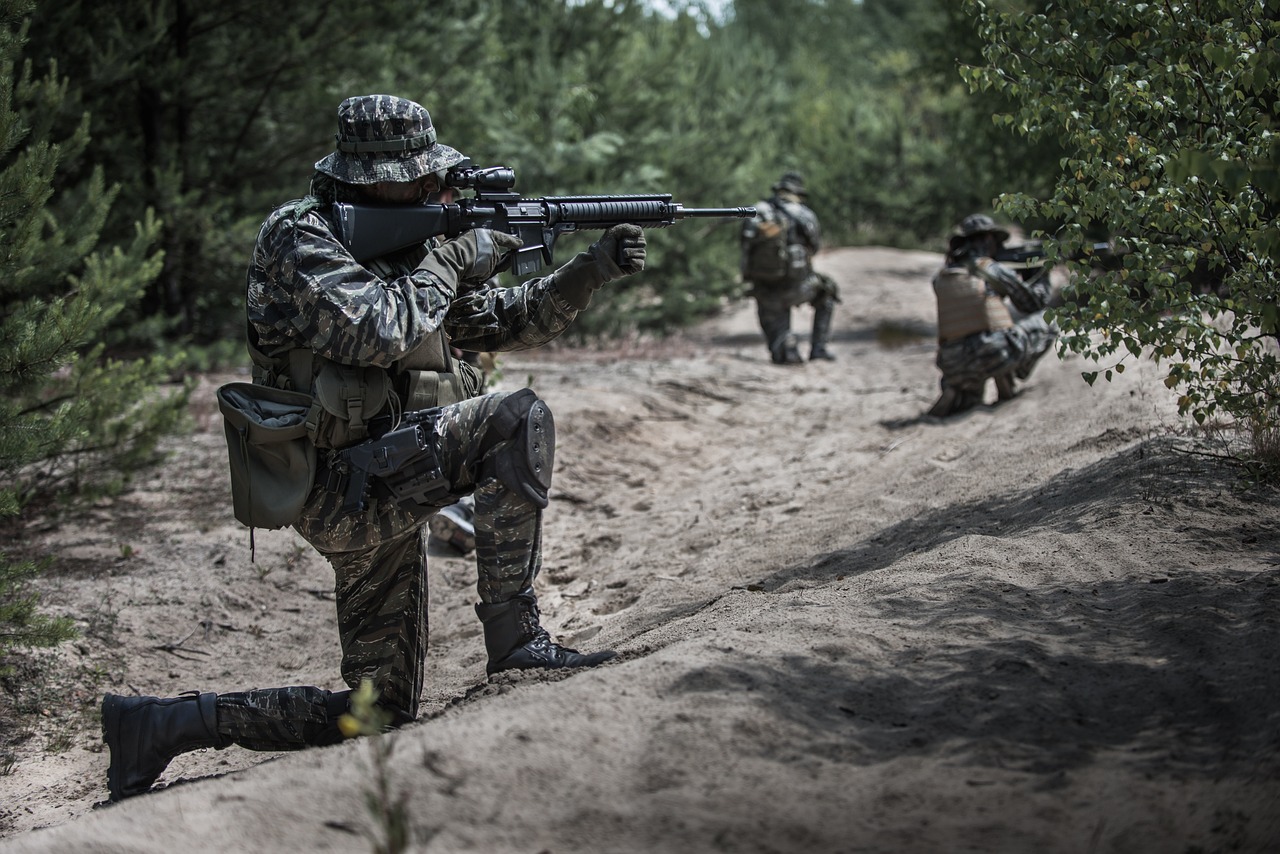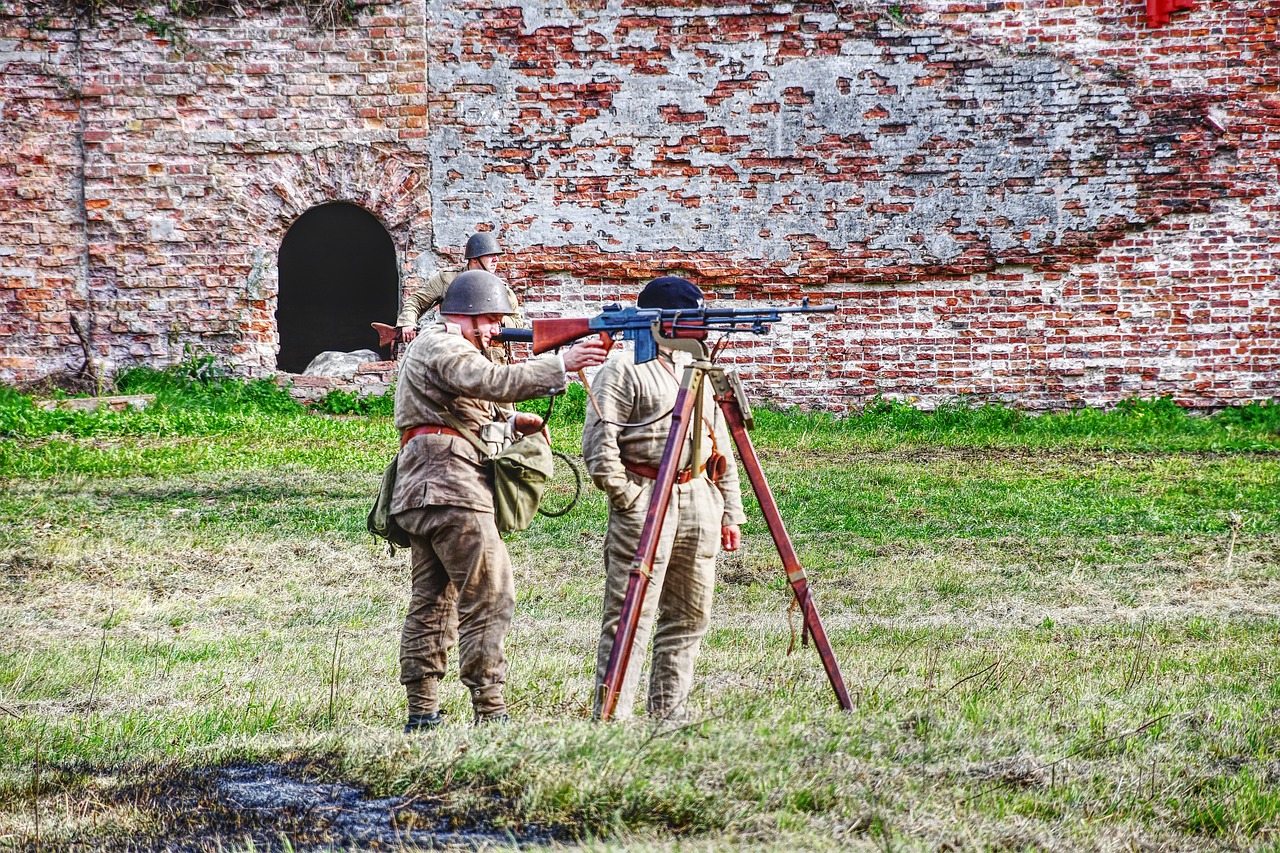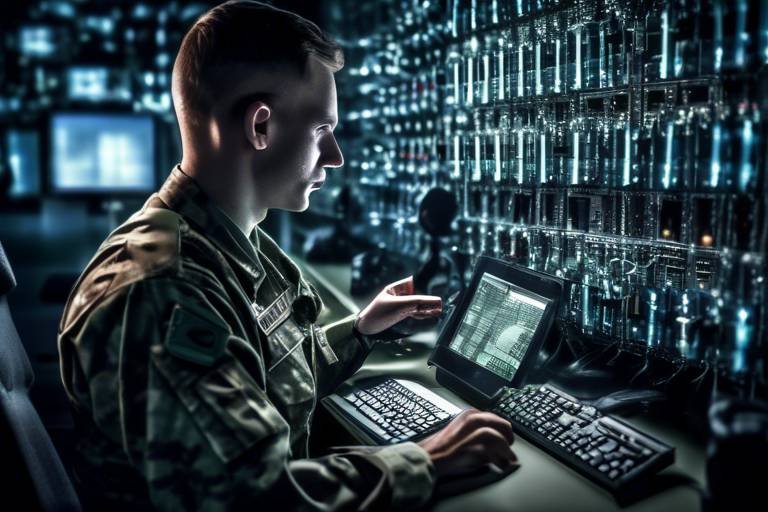AI-Powered Solutions for Enhanced Soldier Protection
In the rapidly evolving landscape of modern warfare, the safety and effectiveness of soldiers on the battlefield are paramount. With the integration of artificial intelligence (AI), military operations are undergoing a transformative change that promises to enhance soldier protection like never before. Imagine a battlefield where technology acts as a guardian, predicting threats, monitoring health, and providing real-time data to commanders. This is not just a futuristic dream; it is becoming a reality through innovative AI technologies. As we delve into this fascinating topic, we will explore various applications of AI in military contexts, the benefits they bring to soldier safety, and the exciting possibilities that lie ahead.
AI is being woven into the fabric of military operations, fundamentally altering how decisions are made, data is analyzed, and efficiency is achieved. By harnessing the power of machine learning and data analytics, military leaders can make informed choices that can mean the difference between life and death. This integration of AI into military operations is not merely about automating tasks; it’s about enhancing human capabilities. For instance, AI can sift through vast amounts of battlefield data in seconds, identifying patterns and predicting enemy movements with astonishing accuracy. This allows commanders to allocate resources more effectively and strategize with a level of precision previously thought impossible.
One of the most significant advancements in soldier protection is the development of AI-driven protective gear. Imagine a smart helmet that not only shields a soldier’s head but also monitors vital health metrics and environmental conditions. These innovations are designed to keep soldiers safe by providing critical information in real-time. For example, if a soldier is in a high-stress situation, their helmet can detect changes in heart rate and alert medics before the soldier even realizes there’s a problem. This proactive approach to health monitoring could be a game changer on the battlefield.
Furthermore, wearable technology plays a crucial role in collecting and transmitting real-time data. This technology enables commanders to track soldiers’ health and location, ensuring that help is always just a call away. The integration of health monitoring systems into soldier gear allows for immediate detection of injuries or stress levels, which is vital for timely medical intervention. In a high-stakes environment, every second counts, and AI can help bridge the gap between injury and treatment.
Environmental awareness tools powered by AI also enhance soldiers' situational awareness. These tools provide critical information about surroundings, potential threats, and environmental hazards, allowing soldiers to navigate complex terrains safely. Imagine a soldier equipped with an AI system that can analyze the environment and suggest the safest routes or warn of incoming threats. This level of awareness can significantly reduce risks and improve decision-making on the ground.
Another exciting application of AI in military operations is the use of autonomous vehicles. These vehicles can transport supplies, evacuate injured personnel, and provide logistical support without putting human lives at risk. By deploying AI-driven vehicles, military forces can ensure that essential operations continue even in the most dangerous situations. This not only saves lives but also allows soldiers to focus on their primary mission without the added worry of logistical challenges.
As we look to the future, the potential of AI in enhancing soldier protection is immense. From tactical decision-making to predictive analytics in combat, the applications are vast and varied. AI systems can assist military leaders in making tactical decisions by quickly analyzing data and predicting enemy movements. This capability allows for a more agile response to changing battlefield conditions. Moreover, AI-powered simulations are revolutionizing military training, providing realistic scenarios that prepare soldiers for various combat situations. The combination of advanced training and real-time data can lead to a more prepared and resilient fighting force.
- How does AI improve soldier safety? AI enhances soldier safety by providing real-time health monitoring, environmental awareness, and predictive analytics that help in decision-making.
- What types of AI technologies are used in military operations? AI technologies include smart helmets, health monitoring systems, autonomous vehicles, and advanced data analytics tools.
- Are there ethical concerns regarding the use of AI in military settings? Yes, ethical concerns include accountability for AI decisions, the potential for misuse, and the need for human oversight in critical situations.
- What is the future of AI in military applications? The future of AI in military applications looks promising, with continued advancements in technology aimed at enhancing soldier protection and operational efficiency.

Understanding AI in Military Applications
Artificial Intelligence (AI) is not just a buzzword; it’s a game-changer in military operations. Imagine a battlefield where decisions are made in the blink of an eye, where data is analyzed not just for the sake of analysis but to save lives and enhance mission success. AI is revolutionizing the way military forces operate, from strategic planning to on-the-ground execution. By integrating AI into military applications, we are unlocking new levels of operational efficiency and effectiveness.
One of the most significant aspects of AI in the military is its capability to process vast amounts of data quickly. Traditional military operations often relied on human analysis, which, while valuable, can be slow and prone to error. With AI, data from various sources—satellite imagery, reconnaissance reports, and even social media—can be analyzed in real-time, providing military leaders with actionable insights. This not only speeds up decision-making but also enhances the accuracy of those decisions. Imagine a scenario where a commander can predict enemy movements based on data patterns—this is the power of AI.
Moreover, AI plays a crucial role in operational efficiency. By automating routine tasks, military personnel can focus on more critical aspects of their missions. For instance, AI systems can handle logistics, supply chain management, and even maintenance schedules for equipment. This means fewer resources are wasted, and soldiers can concentrate on what they do best: executing their missions. The integration of AI leads to greater resource optimization, ensuring that every asset is used to its fullest potential.
Furthermore, AI is enhancing communication within military units. With AI-driven platforms, information can be shared seamlessly among soldiers and command centers, ensuring that everyone is on the same page. This level of connectivity is essential in high-stakes situations where every second counts. In essence, AI is not just a tool; it’s a partner in the battlefield, facilitating collaboration and improving overall mission outcomes.
As we delve deeper into the applications of AI in military settings, it’s important to note that the technology is not without its challenges. While AI can provide significant advantages, it also raises questions about accountability, ethics, and the potential for misuse. The military must navigate these challenges carefully to harness the full potential of AI while ensuring that it is used responsibly.
In summary, the integration of AI into military applications is a transformative force. It enhances decision-making, improves operational efficiency, and fosters better communication among troops. As we continue to explore the capabilities of AI, it’s clear that this technology will play a pivotal role in shaping the future of military operations.
- What are the main advantages of using AI in military operations?
AI enhances decision-making speed and accuracy, automates routine tasks, and improves communication, leading to greater operational efficiency.
- How does AI analyze data in military contexts?
AI systems can process and analyze vast amounts of data from multiple sources in real-time, providing actionable insights for military leaders.
- What ethical concerns are associated with AI in the military?
Concerns include accountability for AI decisions, potential misuse of technology, and the need for maintaining human oversight in critical situations.

AI-Driven Protective Gear
The battlefield is an unpredictable and often perilous environment where every second counts. In this high-stakes arena, is emerging as a game-changer for soldier safety and effectiveness. Imagine a soldier equipped with advanced technology that not only shields them from physical harm but also actively monitors their health and surroundings. This is no longer a distant dream; it is a reality being developed and deployed today.
One of the most exciting innovations in this realm is the creation of smart helmets. These helmets are not just designed to protect against blunt force trauma; they are equipped with sensors that monitor vital signs such as heart rate, temperature, and even stress levels. For instance, if a soldier's heart rate spikes due to stress or injury, the helmet can send an alert to medics, ensuring that help is on the way before the soldier even realizes they need it. This proactive approach to health management can be the difference between life and death in critical situations.
Alongside smart helmets, AI-enhanced body armor is revolutionizing personal protection. This gear is designed to adapt to various threats, whether they be ballistic, shrapnel, or environmental hazards. For example, some body armor can change its rigidity based on the level of impact it detects, providing maximum protection without sacrificing mobility. This adaptability is crucial when soldiers need to maneuver in unpredictable combat situations.
But the advancements don't stop at helmets and body armor. Wearable technology integrated into a soldier's gear plays a vital role in collecting and transmitting real-time data. Imagine a situation where a commander can access live health metrics and locations of all their soldiers on the battlefield. This capability allows for informed decision-making, ensuring that resources are allocated effectively and that soldiers receive timely medical attention when needed.
At the heart of this wearable technology are sophisticated health monitoring systems. These systems can detect injuries or signs of fatigue, alerting medics or commanders instantly. For instance, if a soldier sustains an injury, the system can provide precise location data, allowing for rapid evacuation. This immediate response can significantly improve survival rates and recovery times, showcasing how AI can enhance operational efficiency on the battlefield.
Another critical aspect of AI-driven protective gear is the integration of environmental awareness tools. These tools enhance a soldier's situational awareness by providing real-time information about their surroundings. With the help of AI, soldiers can receive alerts about potential threats, such as enemy movements or hazardous environmental conditions. This capability is akin to having a personal assistant on the battlefield, constantly analyzing data and providing insights that could save lives.
In addition to personal protective gear, AI is also making waves in the realm of autonomous vehicles. These vehicles can transport supplies, evacuate injured personnel, and provide logistical support without putting human lives at risk. Imagine a drone delivering medical supplies to a remote location while soldiers focus on their mission. This seamless integration of technology not only enhances operational efficiency but also allows soldiers to concentrate on what they do best—defending and protecting.
As we look to the future, the potential for AI-driven protective gear is limitless. With ongoing advancements in technology, we can expect to see even more innovative solutions that prioritize soldier safety and effectiveness on the battlefield. The integration of AI into military applications is not just about enhancing capabilities; it's about saving lives and ensuring that our soldiers return home safely.
- What is AI-driven protective gear?
AI-driven protective gear refers to advanced military equipment, such as smart helmets and body armor, that utilizes artificial intelligence to monitor health metrics and enhance situational awareness. - How does wearable technology improve soldier safety?
Wearable technology collects real-time data on soldiers' health and location, allowing commanders to make informed decisions and provide timely medical assistance. - What role do autonomous vehicles play in soldier protection?
Autonomous vehicles can transport supplies and evacuate injured personnel without risking human lives, enhancing overall operational safety. - Are there ethical concerns regarding AI in military applications?
Yes, there are ethical considerations, including accountability in AI decision-making and the need to balance innovation with ethical standards in warfare.

Wearable Technology for Real-Time Data
In today's fast-paced military environment, wearable technology has emerged as a game-changer, providing soldiers with the ability to monitor their health and surroundings in real-time. Imagine a soldier equipped with a smart wristband or a high-tech vest that not only tracks their vital signs but also relays crucial data back to command centers. This technology serves as a lifeline, ensuring that every soldier is not just a participant in the battle but a connected asset capable of enhancing operational effectiveness.
These advanced wearables are designed to collect a myriad of data points, including heart rate, body temperature, and even stress levels. By continuously monitoring these metrics, commanders can gain insights into the physical and mental state of their troops. For instance, if a soldier is experiencing elevated stress levels or shows signs of fatigue, commanders can make informed decisions about their deployment or provide immediate support. This capability is akin to having a personal health assistant right on the battlefield, ready to respond when needed.
Moreover, the integration of GPS technology into these wearables allows for precise tracking of soldiers' locations. This feature is invaluable during chaotic combat situations where communication can break down. With real-time location data, commanders can coordinate movements, ensure that no soldier is left behind, and effectively manage resources. Imagine the peace of mind that comes from knowing that every soldier's position is monitored, allowing for quick responses in emergencies.
One of the most exciting aspects of wearable technology is its potential to integrate with other military systems. For example, data collected from soldiers' wearables can be fed into larger AI-driven analytics platforms. This integration enables predictive analytics, allowing military leaders to anticipate potential issues and act proactively. If a soldier's data indicates a likelihood of injury or exhaustion, it can trigger alerts for medical support or strategic repositioning.
| Feature | Description |
|---|---|
| Health Monitoring | Tracks vital signs such as heart rate and temperature. |
| GPS Tracking | Provides real-time location data for soldiers in the field. |
| Data Integration | Connects with AI systems for enhanced analytics and decision-making. |
In conclusion, the advent of wearable technology in the military is not just about enhancing individual soldier safety; it's about creating a more cohesive and responsive military unit. As these technologies continue to evolve, we can expect even greater advancements that will redefine how soldiers operate on the battlefield. With the right tools, soldiers can focus on their mission while knowing that their health and safety are being monitored and prioritized.
- What types of wearable technology are used by soldiers? Soldiers use a variety of devices, including smart helmets, vests, and wristbands that monitor health metrics and provide GPS tracking.
- How does wearable technology improve soldier safety? By continuously monitoring vital signs and location, commanders can make informed decisions and provide timely support in emergencies.
- Can wearable technology be integrated with other military systems? Yes, data from wearables can be integrated into AI-driven analytics platforms for enhanced decision-making and operational efficiency.

Health Monitoring Systems
In today's fast-paced and unpredictable battlefield, the health and safety of soldiers are paramount. integrated into military gear are revolutionizing how we approach soldier welfare. Imagine a scenario where a soldier is in the thick of combat, yet their vital signs are constantly being monitored, allowing for real-time assessments of their physical condition. These systems are not just a luxury; they are becoming essential tools that can mean the difference between life and death.
At the core of these health monitoring systems are advanced sensors embedded in uniforms and equipment. These sensors continuously track vital metrics such as heart rate, body temperature, and even hydration levels. By collecting this data, commanders can make informed decisions about the health status of their troops. For instance, if a soldier's heart rate spikes significantly, it could indicate stress or potential injury, prompting immediate medical attention. This real-time data transmission ensures that help is never far away, even in the most challenging environments.
Furthermore, these systems often come equipped with AI algorithms that analyze the collected data to detect patterns and anomalies. For example, if a soldier is exhibiting signs of extreme fatigue or dehydration, the system can alert medics before the situation escalates. This proactive approach not only enhances individual soldier safety but also optimizes overall unit performance. When soldiers can rely on technology to monitor their health, they can focus on their mission without the constant worry of their physical state.
In addition to monitoring health metrics, these systems can also integrate with other technologies, such as GPS tracking. This means that not only can a soldier's health be monitored, but their location can also be tracked in real time. In emergencies, this can facilitate quicker evacuations and targeted medical responses. Imagine a situation where a soldier is injured and unable to communicate; the health monitoring system can send out alerts with their exact location, ensuring that help arrives swiftly.
While the benefits of health monitoring systems are clear, it’s essential to consider the challenges as well. Issues such as data privacy and the potential for over-reliance on technology must be addressed. Military leaders must ensure that these systems are used ethically and responsibly, maintaining a balance between innovation and the well-being of their troops.
In conclusion, health monitoring systems represent a significant leap forward in military technology. By providing real-time health data and enhancing situational awareness, these systems not only protect soldiers but also improve operational effectiveness. As we continue to explore the possibilities of AI in the military, the integration of health monitoring systems will undoubtedly play a crucial role in shaping the future of soldier safety.
- What are health monitoring systems?
Health monitoring systems are advanced technologies integrated into military gear that track vital signs and health metrics of soldiers in real-time. - How do these systems improve soldier safety?
By continuously monitoring health data, these systems can alert medical personnel to potential issues before they escalate, ensuring timely intervention. - What types of data do health monitoring systems collect?
They typically track metrics such as heart rate, body temperature, hydration levels, and location through GPS. - Are there any challenges associated with health monitoring systems?
Yes, challenges include data privacy concerns and the potential for over-reliance on technology in critical situations.

Environmental Awareness Tools
In the chaotic environment of the battlefield, maintaining a keen sense of environmental awareness is paramount for the safety and effectiveness of soldiers. This is where AI-powered environmental awareness tools come into play, transforming how military personnel perceive and interact with their surroundings. Imagine being a soldier in a dense forest, where every rustle could signify a potential threat. AI technologies are designed to enhance situational awareness by providing real-time data about the environment, potential hazards, and enemy movements.
These tools utilize advanced sensors and algorithms to analyze vast amounts of data, helping soldiers make informed decisions swiftly. For instance, AI can integrate data from various sources, such as satellite imagery, drones, and ground sensors, to create a comprehensive picture of the operational environment. This integration allows for the identification of environmental hazards, such as toxic gas leaks or extreme weather conditions, which can significantly impact mission success and soldier safety.
One of the most significant aspects of these tools is their ability to process information in real-time. When soldiers are equipped with wearable devices that monitor their surroundings, they can receive alerts about potential threats, such as enemy positions or changes in terrain. These alerts can be life-saving, enabling soldiers to adapt their strategies on the fly. For example, if a soldier enters an area with high radiation levels, the AI system can immediately notify them, allowing for a quick evacuation or a change in tactics.
Moreover, AI-driven environmental awareness tools can also assist in navigation. Using augmented reality (AR) interfaces, soldiers can visualize critical information overlaid on their field of vision. This technology not only enhances situational awareness but also reduces the cognitive load on soldiers, allowing them to focus on executing their missions rather than getting bogged down with information overload. Imagine a soldier seeing a digital map with highlighted safe routes and potential threats directly in their line of sight; it’s like having a tactical guide right in front of them!
In addition to improving safety, these tools can enhance operational efficiency. By analyzing environmental data, AI can help military leaders optimize resource allocation, ensuring that troops are deployed in the most advantageous positions. This capability can significantly increase the chances of mission success while minimizing risks to personnel. As we look to the future, the continued development of AI-powered environmental awareness tools will undoubtedly redefine how military operations are conducted, making them safer and more efficient.
- What are environmental awareness tools in the military?
Environmental awareness tools are AI-powered technologies that help soldiers understand their surroundings by providing real-time data about potential threats, hazards, and enemy movements. - How do these tools enhance soldier safety?
By integrating data from various sources, these tools can alert soldiers to environmental hazards and enemy positions, allowing them to make informed decisions quickly. - Can AI tools assist in navigation?
Yes! AI-driven tools can provide augmented reality interfaces that overlay critical navigation information, helping soldiers find safe routes and avoid dangers. - What is the future of environmental awareness tools in the military?
The future looks promising, with ongoing advancements in AI technology expected to make these tools even more effective, enhancing soldier safety and operational efficiency.

Autonomous Vehicles for Support
In the modern battlefield, the integration of autonomous vehicles is proving to be a game-changer, revolutionizing the way military operations are conducted. These vehicles, which can operate without direct human intervention, are designed to perform a variety of critical tasks that enhance both efficiency and safety for soldiers on the ground. Imagine a scenario where supplies are delivered to the front lines without putting human lives at risk; that’s the promise that autonomous vehicles bring to the table. By utilizing advanced sensors, AI algorithms, and real-time data analysis, these machines can navigate complex environments, avoiding obstacles and responding to threats with remarkable agility.
One of the most significant advantages of autonomous vehicles is their ability to transport supplies and evacuate injured personnel. In a high-stakes situation, every second counts, and the traditional methods of logistics can be slow and cumbersome. Autonomous vehicles can streamline this process, ensuring that essential resources reach their destination swiftly. For instance, consider a medical evacuation scenario where a soldier is injured. An autonomous drone could be dispatched to the location, equipped with necessary medical supplies, while simultaneously transporting the injured soldier to safety. This not only saves time but also minimizes the risk to human medics who would otherwise be exposed to danger.
Moreover, these vehicles are not just limited to transport; they can also provide logistical support in various forms. For example, unmanned ground vehicles (UGVs) can be deployed to scout the terrain, gather intelligence, and even carry out surveillance missions. This capability allows commanders to make informed decisions based on real-time data collected from the field. The use of autonomous vehicles also frees up human resources, allowing soldiers to focus on more strategic tasks rather than mundane logistical duties.
As technology advances, the capabilities of these vehicles continue to expand. Features such as collision avoidance systems, autonomous navigation, and AI-driven decision-making processes are becoming standard. The potential applications are vast, ranging from reconnaissance missions to resupply operations and even direct combat support. Imagine a fleet of autonomous vehicles working in unison, communicating with each other to optimize their routes and tasks, effectively creating a networked support system that enhances operational effectiveness.
However, the integration of autonomous vehicles into military operations is not without its challenges. There are significant considerations regarding safety, reliability, and the ethical implications of deploying machines in combat scenarios. Questions arise about how these vehicles make decisions and the accountability for their actions. As we push the boundaries of technology, it becomes imperative to establish clear guidelines and protocols to ensure that these innovations are used responsibly and effectively.
In summary, autonomous vehicles are setting the stage for a new era in military operations. Their ability to enhance logistics, minimize risk, and improve operational efficiency is paving the way for a future where soldiers can rely on advanced technology to support their missions. As we continue to explore the capabilities of these vehicles, it’s essential to balance innovation with ethical standards, ensuring that the deployment of AI-driven machines aligns with our values and principles. The future of warfare may very well depend on how effectively we can harness these technologies for the benefit of our troops and the success of our missions.
- What are autonomous vehicles in military applications? Autonomous vehicles are machines that can operate without direct human control, designed for tasks such as supply transport, reconnaissance, and logistical support.
- How do autonomous vehicles enhance soldier safety? By performing dangerous tasks like supply transport and medical evacuations without risking human lives, autonomous vehicles significantly improve soldier safety on the battlefield.
- What challenges do autonomous vehicles face in military operations? Challenges include ensuring safety and reliability, addressing ethical concerns, and establishing accountability for their actions during missions.
- What future developments can we expect for autonomous military vehicles? Future developments may include improved AI algorithms, enhanced communication systems, and expanded capabilities for reconnaissance and combat support.

AI for Tactical Decision-Making
Artificial Intelligence is transforming the landscape of military operations, and one of its most significant contributions lies in tactical decision-making. Imagine a chess game where the opponent’s moves are anticipated before they even happen—this is the essence of how AI enhances military strategy. By analyzing vast amounts of data in real-time, AI systems can provide military leaders with insights that were previously unimaginable, allowing them to make swift and informed decisions on the battlefield.
Today’s military leaders face the daunting task of processing information from multiple sources, including satellite imagery, drone surveillance, and ground reports. This is where AI steps in as a game-changer. With its ability to sift through and analyze data at lightning speed, AI can highlight patterns and predict enemy movements. This predictive capability not only enhances situational awareness but also enables commanders to allocate resources more effectively, ensuring that troops are positioned optimally to respond to threats.
For instance, consider a scenario where intelligence indicates a potential enemy attack. An AI system can analyze historical data, current troop movements, and even weather patterns to forecast the most likely routes of attack. This allows commanders to reinforce vulnerable areas or prepare countermeasures before an attack occurs. The result? A tactical advantage that can be the difference between victory and defeat.
Moreover, AI can assist in resource optimization. In military operations, resources such as ammunition, food, and medical supplies are often limited. AI can help in predicting which resources will be needed and when, minimizing waste and ensuring that soldiers have what they need when they need it. This level of foresight is invaluable in high-stakes environments where every second counts.
AI also plays a crucial role in simulations and training. Military strategists can use AI-driven simulations to create realistic combat scenarios that help soldiers prepare for various situations. These simulations can adapt in real-time based on the actions of the participants, providing an immersive training experience that traditional methods simply cannot match. Soldiers can practice decision-making under pressure, learning to think critically and adapt quickly, which is essential for success in actual combat scenarios.
As we delve deeper into the integration of AI in tactical decision-making, it’s essential to recognize that while AI can significantly enhance military capabilities, it is not infallible. The reliance on technology brings forth challenges, including the need for human oversight. Decisions made by AI must be reviewed by experienced military personnel to ensure that ethical standards are upheld and that the human element remains central to military operations.
In summary, AI is revolutionizing tactical decision-making in the military by providing tools that enhance data analysis, predict enemy actions, and optimize resource allocation. As this technology continues to evolve, it holds the potential to reshape how military leaders approach strategy, ultimately leading to more effective and safer operations for soldiers on the ground.
- How does AI improve tactical decision-making in the military?
AI analyzes vast amounts of data quickly, highlighting patterns and predicting enemy movements, which aids military leaders in making informed decisions. - What are the ethical considerations of using AI in military operations?
There are concerns about accountability, the potential for misuse, and the need for human oversight in critical decisions. - Can AI replace human decision-makers in the military?
While AI enhances decision-making capabilities, it cannot replace the critical thinking and ethical judgment of human leaders. - What role does AI play in military training?
AI-driven simulations provide realistic training scenarios, allowing soldiers to practice decision-making under pressure and adapt to changing situations.

Predictive Analytics in Combat
In the ever-evolving landscape of modern warfare, predictive analytics has emerged as a game-changer, transforming how military strategists plan and execute operations. By harnessing the power of data, military leaders can anticipate enemy movements, optimize resource allocation, and make informed decisions that enhance operational success. Imagine having the ability to foresee potential threats before they materialize—this is precisely what predictive analytics offers.
At its core, predictive analytics involves the use of statistical algorithms and machine learning techniques to analyze historical data and identify patterns. In a combat scenario, this means feeding vast amounts of information into sophisticated algorithms that can detect trends and predict future events. For instance, data from previous conflicts can reveal enemy behavior patterns, allowing commanders to anticipate their next move. This proactive approach can mean the difference between victory and defeat on the battlefield.
One of the most significant advantages of predictive analytics is its ability to improve situational awareness. By integrating data from various sources—such as satellite imagery, reconnaissance reports, and real-time battlefield information—military leaders can gain a comprehensive view of the battlefield. This holistic understanding enables them to make quick, effective decisions, ensuring that troops are deployed where they are needed most.
Moreover, predictive analytics can also assist in resource management. For example, by analyzing supply chain data, military planners can predict when and where resources will be needed, allowing for more efficient logistics. This not only saves time and money but also enhances overall mission effectiveness. In situations where every second counts, having the right resources in the right place at the right time can be a decisive factor.
However, the implementation of predictive analytics is not without its challenges. The reliance on data means that the quality and accuracy of the information fed into the system are paramount. As the saying goes, "garbage in, garbage out." If the data is flawed or outdated, the predictions made by the algorithms can lead to catastrophic consequences. Therefore, maintaining high standards for data collection and analysis is crucial to the success of predictive analytics in combat.
In conclusion, the integration of predictive analytics into military operations represents a significant leap forward in enhancing combat effectiveness. By providing military leaders with the tools to foresee potential threats and optimize resource allocation, predictive analytics not only improves situational awareness but also contributes to the overall success of missions. As technology continues to advance, the potential for predictive analytics to shape the future of warfare is boundless.
- What is predictive analytics in combat? Predictive analytics in combat involves using data analysis techniques to forecast enemy movements and optimize military strategies.
- How does predictive analytics improve situational awareness? By integrating data from multiple sources, predictive analytics provides a comprehensive view of the battlefield, helping commanders make informed decisions.
- What are the challenges of implementing predictive analytics? Challenges include ensuring the accuracy and quality of data, as flawed information can lead to incorrect predictions.
- Can predictive analytics be used in other fields? Yes, predictive analytics is widely used in various fields, including healthcare, finance, and marketing, to forecast trends and improve decision-making.

Simulation and Training Enhancements
In the rapidly evolving landscape of military training, AI-powered simulations are proving to be game-changers. Imagine a world where soldiers can experience lifelike combat scenarios without ever stepping onto a real battlefield. That's the magic of simulation technologies! These advanced systems are designed to replicate various combat environments, allowing soldiers to hone their skills in a safe and controlled setting. By immersing them in realistic situations, these simulations prepare troops for the unpredictability of actual combat, enhancing their readiness and confidence.
One of the most exciting aspects of AI simulations is their ability to adapt in real-time. As soldiers engage in training exercises, the AI can analyze their performance and adjust the difficulty level accordingly. This means that no two training sessions are alike; each experience is tailored to the individual's skill set and learning pace. For instance, if a soldier excels in one area but struggles in another, the simulation can increase the complexity of the challenging task while simplifying the areas where they perform well. This personalized approach ensures that every soldier receives the training they need to succeed.
Moreover, these simulations are not just about individual training. Team dynamics play a crucial role in military operations, and AI simulations facilitate collaborative exercises that mimic real-world teamwork. Soldiers can engage in joint missions, where they must communicate and strategize with their peers, fostering critical skills such as leadership and decision-making under pressure. This aspect of training is vital, as it mirrors the collaborative nature of actual military operations, preparing soldiers to function effectively as part of a unit.
Another fascinating feature of AI-driven simulations is their ability to incorporate predictive analytics. By analyzing historical data and patterns, these systems can forecast potential enemy actions and environmental challenges. For instance, if a soldier is training for an urban combat scenario, the simulation might introduce unexpected obstacles based on past conflicts in similar environments. This not only keeps the training fresh and engaging but also equips soldiers with the foresight to adapt their strategies in real time.
| Benefits of AI-Powered Simulations | Description |
|---|---|
| Realism | Provides lifelike scenarios that mimic actual combat situations. |
| Adaptability | Adjusts training difficulty based on individual performance. |
| Team Training | Encourages collaboration and communication among soldiers. |
| Predictive Insights | Utilizes historical data to enhance training scenarios. |
As we look to the future, the potential for AI in military training is boundless. With ongoing advancements in technology, we can expect even more immersive and effective training solutions. Imagine virtual reality headsets that transport soldiers into a fully interactive combat zone or AI algorithms that can simulate enemy strategies with pinpoint accuracy. The sky's the limit! As we embrace these innovations, we must also consider the importance of human oversight in training scenarios. While AI can provide invaluable insights and experiences, the final decision-making should always rest with trained military personnel.
- What are AI-powered simulations?
AI-powered simulations are advanced training tools that replicate real-world combat scenarios, allowing soldiers to practice their skills in a safe environment. - How do these simulations enhance training?
They provide realistic experiences, adapt to individual performance, and foster teamwork, preparing soldiers for actual combat situations. - Can AI simulations predict enemy movements?
Yes, by analyzing historical data, AI simulations can forecast potential enemy actions, enhancing strategic training. - What is the future of AI in military training?
The future holds exciting possibilities, including more immersive technologies like virtual reality and enhanced predictive capabilities.

Ethical Considerations and Challenges
As we delve deeper into the realm of AI-powered solutions for military applications, it's crucial to address the ethical considerations and challenges that accompany this technological revolution. The integration of artificial intelligence in warfare raises profound questions about accountability, decision-making, and the moral implications of using machines in life-and-death situations. Can we trust AI to make the right choices when human lives are at stake? This question looms large as we explore the complexities of AI in military operations.
One of the primary ethical dilemmas is the issue of accountability. When an AI system makes a mistake—say, misidentifying a target or misinterpreting data—who is responsible? Is it the programmer, the military leader who deployed the technology, or the machine itself? Establishing clear guidelines and protocols is essential to ensure that accountability is maintained. Without a robust framework, there is a risk of misuse or errors leading to catastrophic consequences. The military must create standards that govern the use of AI, ensuring that decisions made by these systems are transparent and justifiable.
Moreover, the challenge of balancing innovation with ethical standards cannot be overstated. As the military seeks to leverage AI for enhanced operational efficiency, it must also consider the moral implications of its use. For instance, the deployment of autonomous weapons systems raises concerns about human oversight. Should machines be allowed to make life-and-death decisions? The potential for unintended escalation of conflict or collateral damage is a significant risk that cannot be ignored. It's imperative that military leaders engage in open discussions about the ethical ramifications of AI technology, ensuring that innovation does not come at the expense of humanity.
Furthermore, the potential for bias in AI algorithms poses another ethical challenge. If the data used to train AI systems is biased, the outcomes can lead to unfair treatment of certain groups or individuals. This is particularly concerning in military operations, where decisions can have far-reaching consequences. To mitigate this risk, it is essential to implement rigorous testing and validation processes that scrutinize AI systems for biases before they are deployed in the field. A commitment to ethical AI development will not only enhance trust but also improve operational effectiveness.
In conclusion, while AI technologies offer tremendous potential for enhancing soldier protection and operational efficiency, the ethical considerations and challenges they present must be addressed head-on. By establishing clear accountability frameworks, balancing innovation with ethical standards, and ensuring fairness in AI algorithms, the military can harness the power of AI responsibly. The road ahead may be fraught with challenges, but with careful planning and a commitment to ethical practices, we can navigate this complex landscape.
- What are the main ethical concerns regarding AI in the military?
The primary concerns include accountability for AI decisions, the potential for bias in algorithms, and the implications of autonomous weapon systems. - How can accountability be ensured in AI decision-making?
Establishing clear guidelines and protocols, along with transparent decision-making processes, is essential for maintaining accountability. - Is it safe to use AI for life-and-death decisions in combat?
This is a contentious issue, as it raises questions about human oversight and the moral implications of allowing machines to make such critical decisions. - What steps can be taken to mitigate bias in AI systems?
Implementing rigorous testing and validation processes for AI algorithms can help identify and rectify biases before deployment.

Ensuring Accountability in AI Decisions
As we plunge deeper into the age of artificial intelligence, particularly within military applications, the question of accountability becomes paramount. Who is responsible when an AI system makes a mistake? This is not just a theoretical concern; it’s a pressing issue that could have real-world consequences on the battlefield. As AI systems take on more critical roles, it is essential to establish clear guidelines and protocols that dictate how these technologies operate and who is held accountable for their decisions.
One of the most effective ways to ensure accountability in AI decisions is through the implementation of a transparent decision-making framework. This framework should outline the processes by which AI systems analyze data and arrive at conclusions. By making these processes transparent, military leaders can better understand the rationale behind AI-driven decisions, and in turn, hold the appropriate parties accountable. Transparency not only builds trust among military personnel but also fosters a culture of responsibility.
Moreover, it is crucial to integrate a system of checks and balances into AI operations. This involves having human oversight at critical decision points. For instance, while AI might analyze battlefield data and suggest strategies, a human commander should always have the final say. This dual-layer approach ensures that even if an AI system operates autonomously, there is still a human element involved in the decision-making process, mitigating the risk of errors or unintended consequences.
Additionally, establishing a comprehensive training program for military personnel on how to interact with and oversee AI systems is vital. Soldiers and commanders must be equipped with the knowledge to understand AI capabilities and limitations. This training should include:
- Understanding AI algorithms and their decision-making processes
- Identifying potential biases in AI outputs
- Recognizing when to intervene in AI-driven decisions
Furthermore, the development of ethical guidelines specific to AI in military settings is essential. These guidelines should address the potential risks associated with AI, such as unintended escalation of conflict or misinterpretation of data. By having a clear set of ethical standards, military organizations can navigate the complex landscape of AI technologies while maintaining a commitment to responsible use.
In conclusion, ensuring accountability in AI decisions within military operations is not merely a technical challenge; it is a moral imperative. By fostering transparency, incorporating human oversight, providing comprehensive training, and establishing ethical guidelines, we can harness the power of AI while safeguarding against its potential pitfalls. As we move forward, the question will not just be about how we use AI, but also about how we hold ourselves accountable for its actions.
- What are the main concerns regarding AI accountability in the military? The primary concerns include the risk of errors in decision-making, potential biases in AI algorithms, and the need for human oversight in critical situations.
- How can transparency be achieved in AI decision-making? Transparency can be achieved by documenting AI processes, making algorithms understandable, and allowing military personnel to review AI-driven decisions.
- Why is human oversight important in AI operations? Human oversight is crucial to ensure that decisions made by AI align with ethical standards and to prevent unintended consequences that may arise from autonomous actions.

Balancing Innovation with Ethical Standards
In the rapidly evolving landscape of military technology, the integration of artificial intelligence (AI) brings forth a myriad of exciting possibilities. However, with great power comes great responsibility. The challenge lies in balancing innovation with ethical standards to ensure that these advanced technologies are used responsibly and do not compromise human values. As we delve deeper into this issue, it becomes evident that establishing a framework for ethical AI use in military applications is not just a necessity but a moral obligation.
First and foremost, the potential for misuse of AI technologies in warfare raises significant concerns. For instance, autonomous weapons systems that can make life-and-death decisions without human intervention pose a serious ethical dilemma. How do we ensure that these machines adhere to the laws of armed conflict? This is where accountability becomes crucial. Military organizations must develop clear guidelines and protocols that dictate how AI systems operate, ensuring that human oversight remains a cornerstone of any decision-making process.
Moreover, the transparency of AI algorithms is essential. If a soldier or commander is to trust AI-generated recommendations, they need to understand how those conclusions were reached. This transparency can be achieved through rigorous testing and validation of AI systems, demonstrating their reliability and ethical alignment. By fostering an environment of trust, military personnel can confidently integrate these technologies into their operations.
Another critical aspect of this balance is the need to engage with a diverse range of stakeholders. This includes ethicists, technologists, military personnel, and even the general public. By bringing together different perspectives, we can better understand the potential implications of AI in warfare and create a more comprehensive ethical framework. This dialogue can help identify potential risks and develop strategies to mitigate them, ensuring that innovation does not outpace ethical considerations.
Furthermore, it is essential to keep in mind the human element in military operations. While AI can enhance efficiency and effectiveness, it should never replace the judgment and intuition of trained military personnel. The ability to make nuanced decisions based on context, morality, and empathy is something that machines cannot replicate. Thus, maintaining a human-centric approach in the development and deployment of AI technologies is paramount.
As we look to the future, the military must remain vigilant in addressing the ethical challenges posed by AI. Continuous training and education on ethical AI use should be integrated into military programs, ensuring that all personnel are equipped to navigate these complex issues. By fostering a culture of ethical awareness, we can ensure that innovation serves humanity rather than undermines it.
- What are the main ethical concerns regarding AI in the military?
The primary concerns include accountability, transparency, and the potential for misuse of autonomous systems in warfare.
- How can military organizations ensure accountability in AI decision-making?
By establishing clear guidelines and protocols that require human oversight and rigorous testing of AI systems.
- Why is transparency important in AI algorithms?
Transparency allows military personnel to understand how AI systems arrive at their conclusions, fostering trust in their recommendations.
- How can diverse stakeholder engagement improve ethical AI use?
Engaging a wide range of stakeholders helps identify potential risks and develop a more comprehensive ethical framework for AI deployment.
Frequently Asked Questions
- What is the role of AI in military applications?
AI plays a crucial role in military operations by enhancing decision-making, improving data analysis, and increasing operational efficiency. It helps military leaders quickly process vast amounts of information, enabling them to make informed decisions on the battlefield.
- How does AI enhance soldier protective gear?
AI enhances soldier protective gear through innovations like smart helmets and body armor that monitor health metrics and environmental conditions. These technologies help keep soldiers safe by providing real-time data about their health and surroundings.
- What are wearable technologies in military gear?
Wearable technologies in military gear refer to devices that collect and transmit real-time data regarding soldiers' health and location. This information allows commanders to make timely decisions, ensuring the safety and effectiveness of troops in various situations.
- How do health monitoring systems work?
Health monitoring systems integrated into soldier gear can detect injuries or stress levels and alert medics promptly. These systems provide vital information that can be critical for timely medical intervention in combat scenarios.
- What are the benefits of autonomous vehicles in military operations?
Autonomous vehicles provide logistical support by transporting supplies and evacuating injured personnel without risking human lives. This technology allows for safer and more efficient operations on the battlefield.
- How does AI assist in tactical decision-making?
AI assists military leaders in tactical decision-making by analyzing large datasets quickly, predicting enemy movements, and optimizing resource allocation. This capability enhances strategic planning and operational success in combat scenarios.
- What is predictive analytics in combat?
Predictive analytics in combat involves using AI to anticipate enemy actions and adjust military strategies accordingly. This proactive approach helps military strategists stay one step ahead of their adversaries.
- How are AI-powered simulations used in military training?
AI-powered simulations provide realistic training scenarios that prepare soldiers for various combat situations. These simulations enhance training effectiveness by allowing soldiers to experience and react to different scenarios in a controlled environment.
- What are the ethical considerations of using AI in the military?
Ethical considerations include the potential risks of AI decision-making, accountability issues, and the importance of maintaining human oversight. It's crucial to establish guidelines to ensure responsible use of AI in military operations.
- How can accountability be ensured in AI decisions?
Ensuring accountability in AI decisions involves establishing clear guidelines and protocols to prevent misuse or errors. It's essential to have a framework that outlines responsibilities and oversight in AI applications within military contexts.
- How do we balance innovation with ethical standards in military AI?
Balancing innovation with ethical standards involves ongoing discussions about the responsible use of AI in warfare. It requires collaboration between technologists, military leaders, and ethicists to ensure that advancements do not compromise ethical principles.



















